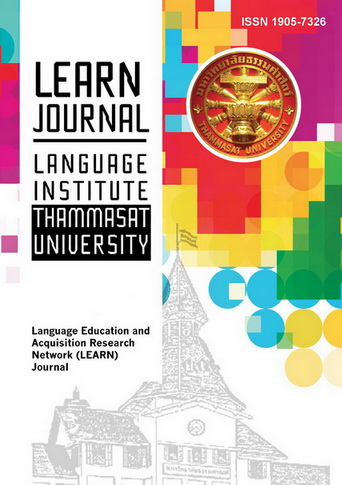Move Analysis of Chemical Biology Research Article Introductions
Main Article Content
Abstract
Writing research articles is an important and demanding task for members of academia, and the introduction is generally considered the most difficult portion to write (Swales, 1990). Move analysis has proven useful in studying the communicative functions of introductions and other sections of research articles, and is thus beneficial in training novice academic authors. Few studies have included a move analysis on the introduction of research articles in the emerging field of chemical biology. In this study, we conducted a move analysis on 10 research article introductions from a prestigious chemical biology journal to identify their rhetorical structure. The results reveal that all introductions analysed consist of three conventional moves — Move 1: Introducing the research area; Move 2: Pointing out the need(s); and Move 3: Presenting the current research, arranged in two common patterns — Pattern A: (Move 1>Move 2)n>Move 3; and Pattern B: (Move 1>Move 2)n>Move 1>Move 3, where n = a counting number. Insights on the general move patterns as well as variations in submoves frequency from research article introductions from the neighbouring disciplines are helpful to novice chemical biologists in writing successful introductions as well as ESP teachers, especially those who teach these scientists writing for publication.
Article Details
References
Ahamad, M. & Yusof, A. (2012). A genre analysis of Islamic academic research article introductions. Procedia – Sciences and Behavioral, 66(7), 157-168. https://doi.org/10.1016/j.sbspro.2012.11.257
Aitkenhead, D. (2013, December 6). Peter Higgs: I wouldn’t be productive enough for today’s academic system. The Guardian. https://www.theguardian.com/science/2013/dec/06/peter-higgs-boson-academic-system
Atai, M. R. & Samani, A. S. (2012). Exploring genre variations in research article introductions within a single subdiscipline: EOP versus EAP. Asian ESP Journal, 8(1), 5-23.
Behnam, B. & Nikoukhesal, A. (2017). A contrastive study of move structure in the introduction section of physical versus social sciences research articles in English. Asian ESP Journal, 13(2), 180-211.
Biber, D., Conner, U., & Upton, T. A. (2007). Discourse on the move: Using corpus analysis to describe discourse structure. John Benjamins Publishing Company.
Brod, S. & Hazelwood-Smith, S. (2014, November 3). How to get published in high-Impact journals: Big research and better writing. Naturejobs. http://blogs.nature.com/naturejobs/2014/11/03/how-to-get-published-in-high-impact-journals-big-research-and-better-writing/
Clapham, P. (2005). Publish or perish. BioScience, 55(5), 390-391. https://doi.org/10.1641/0006-3568(2005)055[0390:POP]2.0.CO;2
Guo, Y. (2014). Asian undergraduate students' apprenticeship in research paper writing: academic interactions and researchers' responsibilities. Asian EFL Journal, 16(1), 53-88.
Hoffmann, R. (2012). Editorial: What, another Nobel Prize in chemistry to a nonchemist?. Angewandte Chemie International Edition, 51, 1734-1735. https://doi.org/10.1002/anie.201108514
Hyland, K. (2016). Academic publishing and the myth of linguistic injustice. Journal of Second Language Writing, 31, 58-69. https://doi.org/10.1016/j.jslw.2016.01.005
Kachru, B. B. (1985). Standards, codification and sociolinguistic realism: The English language in the outer circle. In R. Quirk & H. G. Widdowson (Eds.), English in the world: Teaching and learning the language and literatures (pp. 11-30). Cambridge University Press.
Kanoksilapatham, B. (2005). Rhetorical structure of biochemistry research articles. English for Specific Purposes, 24(3), 269–292. https://doi.org/10.1016/j.esp.2004.08.003
Kanoksilapatham, B. (2012). Structure of research article introductions in three Engineering subdisciplines. IEEE TRANSACTIONS ON PROFESSIONAL COMMUNICATION, 55(4), 294-309. https://doi.org/10.1109/TPC.2012.2223252
Lautamatti, L. (1990). Coherence in spoken and written discourse. In U. Connor & A. M. Johns (Eds.), Coherence in writing: research and pedagogical perspectives (pp. 29-40). Teachers of English to Speakers of Other Languages (TESOL).
Manzoor, H., Majeed, A., & Munaf, M. (2020). Genre analysis of civil engineering’s research article introductions. International Journal of English Linguistics, 10(2), 322-330. https://doi.org/10.5539/ijel.v10n2p322
Paltridge, B. (2012). Discourse analysis: An introduction (2nd ed.). Bloomsbury Publishing.
Pérez-Llantada, C., Plo, R., & Ferguson, G. (2011). You don’t say what you know, only what you can: The perceptions and practices of senior Spanish academics regarding research dissemination in English. English for Specific Purposes, 30(1), 18-30. https://doi.org/10.1016/j.esp.2010.05.001
Phothongsunan, S. (2016). Thai university academics’ challenges of writing for publication in English. Theory and Practice in Language Studies, 6(4), 681- 685. http://dx.doi.org/10.17507/tpls.0604.04
Samraj, B. (2002). Introductions in research articles variations across disciplines. English for Specific Purposes, 21(1), 1-17. https://doi.org/10.1016/S0889-4906(00)00023-5
Stoller, F. L. & Robinson, M. S. (2013). Chemistry journal articles: An interdisciplinary approach to move analysis with pedagogical aims. English for Specific Purposes, 32(1), 45-57. https://doi.org/10.1016/j.esp.2012.09.001
Swales, J. M. (1990). Genre analysis: English in academic and research settings. Cambridge University Press.
Swales, J. M. (2004). Research genres: Exploration and applications. Cambridge University Press.
Swales, J. M. & Feak, C. B. (1994). Academic writing for graduate students: Essential tasks and skills. The University of Michigan Press.
van Dalen, H. P. & Henkens, K. (2012). Intended and unintended consequences of a publish-or-perish culture: A worldwide survey. Journal of the American Society for Information Science and Technology, 63(7), 1282-1293. https://doi.org/10.1002/asi.22636


